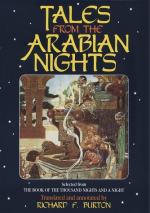To please his sister, the young man once more sets out, and coming to the eldest of the lamiae and telling her his errand, “O my son,” said she, “thou canst go there, but as to carrying away the mistress of the handkerchief, that is not so easy. However, try in some way to obtain possession of her ring, for therein lies all her power.” So he continues his journey, and after passing the lion and the lamb he comes to the chamber of the Belle of the Earth. He finds her asleep, and approaching her noiselessly draws the ring from her finger, upon which she awakes and discovering that she had not her ring, there was no alternative but to submit to his will. They set out together and in the twinkling of an eye arrived at the young man’s house. On perceiving them the sister was overcome with joy.
It happened next day that the King again went to the cafe, and on his return home ordered supper to be prepared, saying that he had invited the young man and all his friends. The sisters instructed the cooks to put poison in the food, which they did accordingly. At nightfall the young man arrived, accompanied by the Belle of the Earth, whom he had married, and his sister. But none of them, notwithstanding the entreaties of the King, would touch any food, for the Belle of the Earth had revealed to them that the meats were poisoned: they merely ate a few mouthfuls out of the King’s mess.
Supper over, the King invited each one to tell a story, and when it came to the young man’s turn, he recounted the whole story of his adventures. Then the King recognised in him the son of his fairest wife, whom, deceived by the lies of her sisters, he had exposed on the staircase. So he instantly ordered the two sisters to be seized and cut to pieces, and he took back his wife. As for the young man, he became his heir. He grew old and prospered.
The points of difference between, and the relative merits of, Galland’s story and Straparola’s
Italianversion,
and whence both were probably obtained, will be considered later on, as several other versions or variants remain to be noticed or cited, before attempting a comparative analysis, not the least interesting of which is a
Bretonversion.
In “Melusine,” for 1878, colt 206 ff., M. Luzel gives a Breton version, under the title of “Les Trois Filles du Boulanger; ou, L’Eau qui dense, la Pomme qui chante, et l’Oiseau de Verite,” which does not appear to have been derived from Galland’s story, although it corresponds with it closely in the first part. A prince overhears the conversation of three daughters of an old baker, who is a widower. The eldest says that she loves the king’s gardener, the second, that she loves the king’s valet, and the youngest says the prince is her love, to whom she would bear two boys, each with a star of gold on his brow, and a girl, with a star of silver. The father chides them for talking




